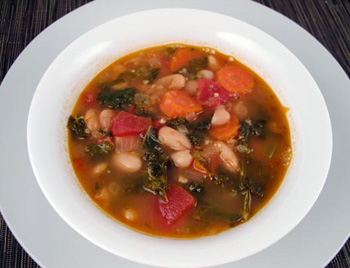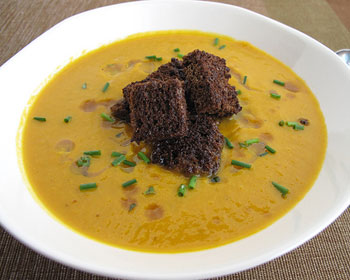 I love making big batches of soup on the weekend. I store some of it in the refrigerator, and the rest I freeze in quart containers for when I need a quick lunch or dinner. I also prefer using homemade chicken stock, which I also keep in the freezer.
I love making big batches of soup on the weekend. I store some of it in the refrigerator, and the rest I freeze in quart containers for when I need a quick lunch or dinner. I also prefer using homemade chicken stock, which I also keep in the freezer.
Whenever I have a rotisserie chicken from the market, I throw whatever is left in a pot with an onion, celery, some peppercorns and cover with 3 or 4 quarts of water and boil for an hour or two to create a rich and flavorful stock.
This traditional Italian soup is one of my favorites – it uses mostly basic ingredients, but is so delicious. The flavors intensify as it sits, so it’s even better the next day.

 Steak and Mushrooms…Yum.
Steak and Mushrooms…Yum. Move over apple turnovers. Here comes pumpkin.
Move over apple turnovers. Here comes pumpkin. This cake. It was my Dad's favorite. He had a Fall birthday and this is the dessert my Mom made him every year for his office celebration. It was also the batter my Mom could barely keep us kids away from....it was so good, even before it was baked. This was back in the day when no one cared about eating raw cake batter.
This cake. It was my Dad's favorite. He had a Fall birthday and this is the dessert my Mom made him every year for his office celebration. It was also the batter my Mom could barely keep us kids away from....it was so good, even before it was baked. This was back in the day when no one cared about eating raw cake batter. On cold days nothing gives me more comfort than hot soup. The flavor combination that I find most comforting in soups is sweet and savory. It's an ideal pairing in many foods that have come to represent autumn. Certain vegetables like sweet potatoes and squashes are all made more flavorful with a touch of sweet, be it from sugar or other sweeteners such as honey or molasses.
On cold days nothing gives me more comfort than hot soup. The flavor combination that I find most comforting in soups is sweet and savory. It's an ideal pairing in many foods that have come to represent autumn. Certain vegetables like sweet potatoes and squashes are all made more flavorful with a touch of sweet, be it from sugar or other sweeteners such as honey or molasses.